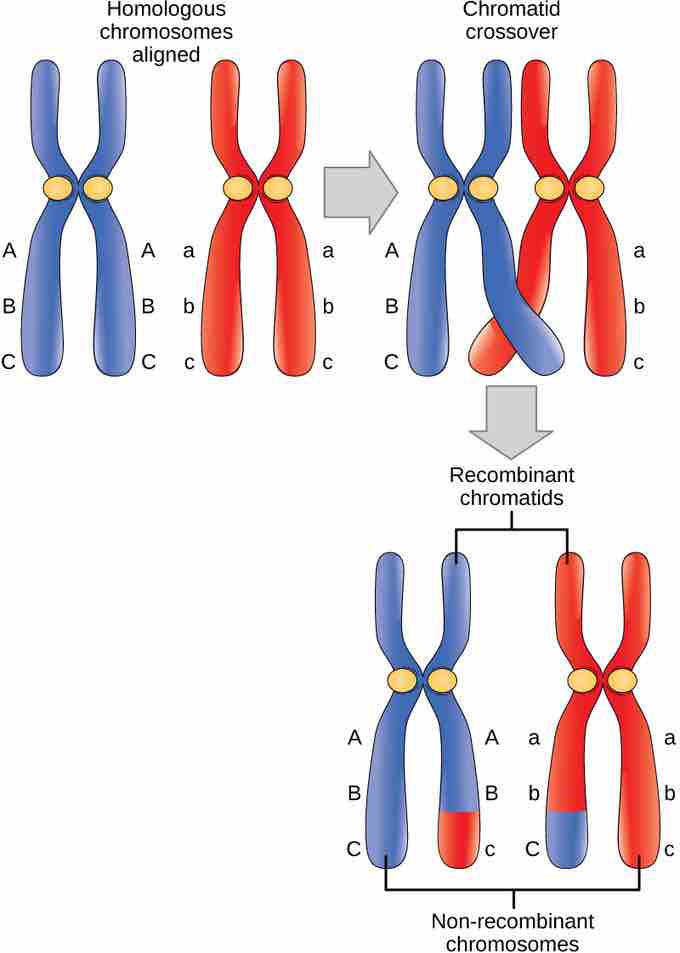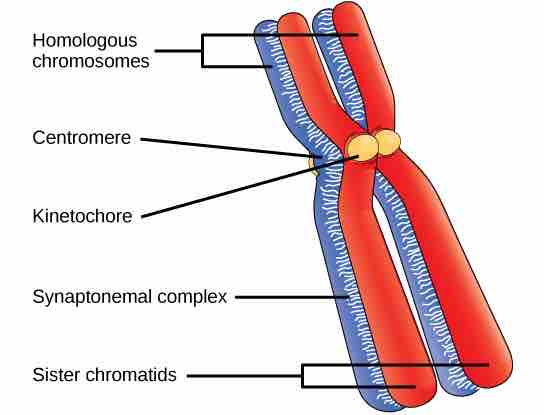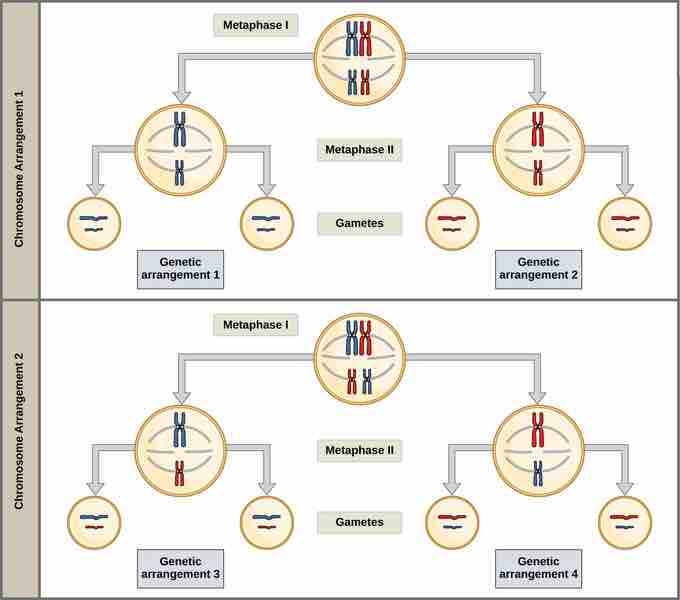Meiosis I
Meiosis is preceded by an interphase consisting of three stages. The G1 phase (also called the first gap phase) initiates this stage and is focused on cell growth. The S phase is next, during which the DNA of the chromosomes is replicated. This replication produces two identical copies, called sister chromatids, that are held together at the centromere by cohesin proteins. The centrosomes, which are the structures that organize the microtubules of the meiotic spindle, also replicate. Finally, during the G2 phase (also called the second gap phase), the cell undergoes the final preparations for meiosis.
Prophase I
During prophase I, chromosomes condense and become visible inside the nucleus. As the nuclear envelope begins to break down, homologous chromosomes move closer together. The synaptonemal complex, a lattice of proteins between the homologous chromosomes, forms at specific locations, spreading to cover the entire length of the chromosomes . The tight pairing of the homologous chromosomes is called synapsis. In synapsis, the genes on the chromatids of the homologous chromosomes are aligned with each other. The synaptonemal complex also supports the exchange of chromosomal segments between non-sister homologous chromatids in a process called crossing over. The crossover events are the first source of genetic variation produced by meiosis. A single crossover event between homologous non-sister chromatids leads to an exchange of DNA between chromosomes . Following crossover, the synaptonemal complex breaks down and the cohesin connection between homologous pairs is also removed. At the end of prophase I, the pairs are held together only at the chiasmata; they are called tetrads because the four sister chromatids of each pair of homologous chromosomes are now visible.

Crossover between homologous chromosomes
Crossover occurs between non-sister chromatids of homologous chromosomes. The result is an exchange of genetic material between homologous chromosomes.

Synapsis holds pairs of homologous chromosomes together
Early in prophase I, homologous chromosomes come together to form a synapse. The chromosomes are bound tightly together and in perfect alignment by a protein lattice called a synaptonemal complex and by cohesin proteins at the centromere.
Prometaphase I
The key event in prometaphase I is the formation of the spindle fiber apparatus where spindle fiber microtubules attach to the kinetochore proteins at the centromeres. Microtubules grow from centrosomes placed at opposite poles of the cell. The microtubules move toward the middle of the cell and attach to one of the two fused homologous chromosomes at the kinetochores. At the end of prometaphase I, each tetrad is attached to microtubules from both poles, with one homologous chromosome facing each pole. In addition, the nuclear membrane has broken down entirely.
Metaphase I
During metaphase I, the tetrads move to the metaphase plate with kinetochores facing opposite poles. The homologous pairs orient themselves randomly at the equator. This event is the second mechanism that introduces variation into the gametes or spores. In each cell that undergoes meiosis, the arrangement of the tetrads is different. The number of variations is dependent on the number of chromosomes making up a set. There are two possibilities for orientation at the metaphase plate. The possible number of alignments, therefore, equals 2n, where n is the number of chromosomes per set. Given these two mechanisms, it is highly unlikely that any two haploid cells resulting from meiosis will have the same genetic composition .

Meiosis I ensures unique gametes
Random, independent assortment during metaphase I can be demonstrated by considering a cell with a set of two chromosomes (n = 2). In this case, there are two possible arrangements at the equatorial plane in metaphase I. The total possible number of different gametes is 2n, where n equals the number of chromosomes in a set. In this example, there are four possible genetic combinations for the gametes. With n = 23 in human cells, there are over 8 million possible combinations of paternal and maternal chromosomes.
Anaphase I
In anaphase I, the microtubules pull the attached chromosomes apart. The sister chromatids remain tightly bound together at the centromere. The chiasmata are broken in anaphase I as the microtubules attached to the fused kinetochores pull the homologous chromosomes apart.
Telophase I and Cytokinesis
In telophase I, the separated chromosomes arrive at opposite poles. In some organisms, the chromosomes decondense and nuclear envelopes form around the chromatids in telophase I. Then cytokinesis, the physical separation of the cytoplasmic components into two daughter cells, occurs without reformation of the nuclei. In nearly all species of animals and some fungi, cytokinesis separates the cell contents via a cleavage furrow (constriction of the actin ring that leads to cytoplasmic division). In plants, a cell plate is formed during cell cytokinesis by Golgi vesicles fusing at the metaphase plate. This cell plate will ultimately lead to the formation of cell walls that separate the two daughter cells.
Two haploid cells are the end result of the first meiotic division. The cells are haploid because at each pole there is just one of each pair of the homologous chromosomes. Therefore, only one full set of the chromosomes is present. Although there is only one chromosome set, each homolog still consists of two sister chromatids.